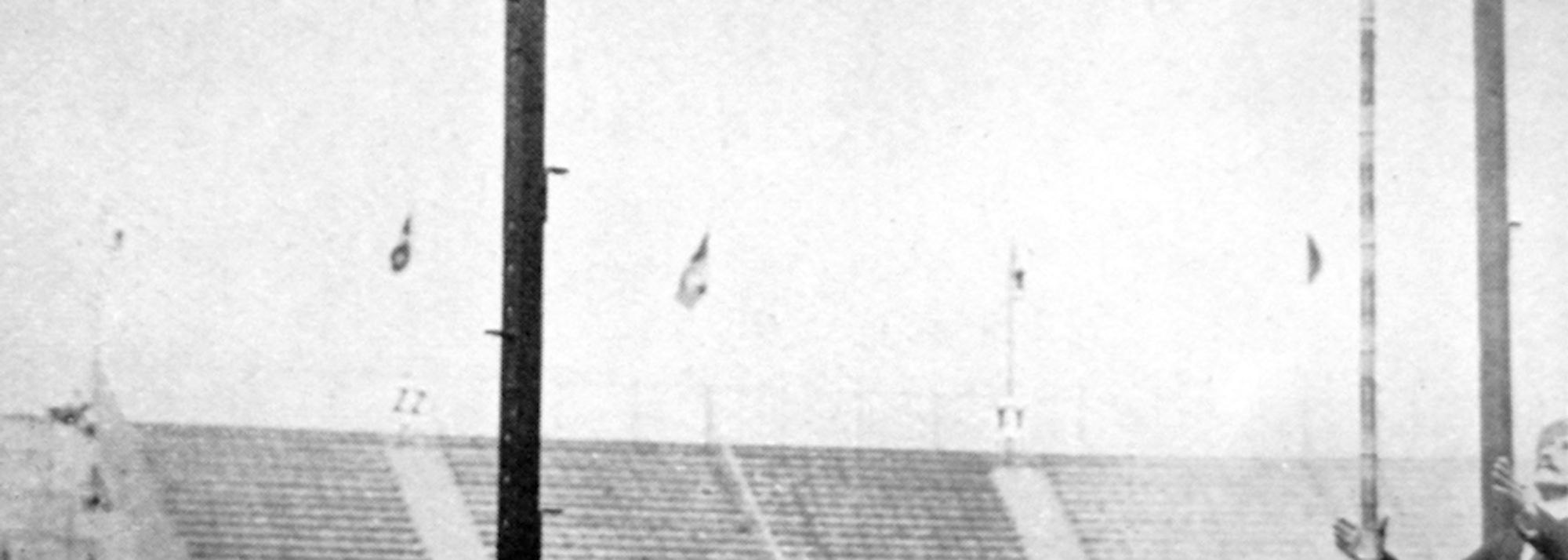Alfred Carlton Gilbert
After finding out how Willie Banks accidentally invented the slow, rhythmic hand clap in 1981, we take another trip down memory lane. This time, SPIKES learns how the pole vault box, a revolutionary track and field invention, was created by the legendary Alfred Carlton Gilbert.
Gilbert was best known as ‘The Man Who Saved Christmas’, but more importantly to us, he was the living proof that track and field athletes are some of the greatest people on earth.
Apart from being a genius toy designer, other skills listed on Gilbert’s gob-smacking and scarcely believable CV were magician, performer, broadcaster, dog breeder, hunter and a world record holder for chin-ups.
Oh, and the American renaissance man also revolutionised the pole vault by creating the vault box, setting two world records and sharing a controversy-fuelled Olympic gold medal at the 1908 London Games.
Born in Salem, Oregon in 1884 – and known as ‘Gilly’ to his friends – was a small, frail boy, but defied his diminutive frame to excel at weightlifting, gymnastics and running and gradually built an impressively chiselled body.
A prominent American footballer and wrestler, the gifted all-around athlete – who transferred from Pacific University to Yale University in 1902 to study medicine and paid his fees by performing as a magician – could climb a 25m rope in seven seconds. He also set a collegiate record for the ‘running long dive’, or long jump as it is now known.
Athletes nowadays still benefit from Gilbert's revolutionary invention
His range of athletic gifts and scientific mind proved a perfect fit for the pole vault, and in 1906 he set the first of his two world records with a clearance of 12 ft 3 ins [3.73m].
Yet, while vaulters of that era were using rudimentary poles made from wooden sticks with a 6 inch spike at the bottom, Gilbert bucked the trend to opt for a more flexible bamboo pole instead of the awkward and potentially dangerous spike. Moreover, he came up with the idea to dig a hole in the ground in front of the bar for greater stability. It was the world’s first pole vault box.
He went into the 1908 London Olympics as overwhelming favourite. Yet, after digging his usual hole in the ground – nothing in the rules prevented it – stuffy English officials, who saw the Brits as pioneers in the pole vault world, prevented him for doing so. They also banned him from competing with his bamboo pole.
Undeterred, Gilbert competed with the wooden stick and spike – even though he saw it archaic and dangerous – and qualified second for the final with 12 ft [3.65m]. His compatriot Edward Tiffin Cook Jr. cleared 12 ft 2 ins [3.70m].
In the final, however, despite clearing 12 ft 2 ins – to Cook’s 11 ft 9 ins [3.58m] – British officials mystifyingly awarded a tie decreeing as Cook had jumped 12 ft 2 ins in qualifying. The gold should be shared.
No box allowed - Cook during the 1908 Olympic Games
Despite the baffling decision, Gilbert remained deeply connected with both pole vault and sport for the next 40 years. He served as a member of the American Olympic Association for many years and later guided Yale’s Sabin Carr to the world pole vault record and Olympic gold at the1928 Amsterdam.
He also served as chef de mission for the US Olympic teams at the 1932 and 1936 Games and as a member-at-large of the USOC at the 1948 London Olympics. On his death in 1961, the Encyclopaedia Britannica declared a pole vault article he published as a work of scientific genius.
Besides his major contribution to pole vaulting, he co-founded Mysto Manufacturing – later to become the A.C. Gilbert Company – which designed and made magic sets. Yet, his major breakthrough came when he invented the Erector Set – a construction toy – which was introduced to the public in 1913.
The beauty of the toy is that it could be built, taken apart and then built into something else. It became the first nationally advertised toy in the USA and was widely regarded as ‘The World’s Greatest Toy’.
Bend it like Bubka – he wouldn't have hit the same career heights without the box
During the First World War, Gilbert successfully argued against the Council of National Defense’s move to stop toy production to focus resources on the military campaign by saying that toys helped prepare young minds for adulthood. Gilly was hailed “The Man Who Saved Christmas” – a feature film was made of the same name in 2002 with Jason Alexander playing the role of Gilbert.
The Erector Set sold more than 30 million in his lifetime and in 1949 it was used to build the precursor to the first modern artificial heart pump at the Yale School of Medicine. Later, chemist Otto Wichterle invented the soft contact lens using an erector set.
Gilbert was credited as originating the concept of providing benefits to his employees, and he co-founded the Toy Manufacturers of America of which he was the first president.
At the time of his death in 1961, aged 76, he had accumulated more than 150 patents in his career including model trains, glass blowing kits and a miniature atomic energy lab complete with real radioactive particles and working Geiger counter.
A museum in his birthplace of Salem in Oregon named the A.C Gilbert Discovery Village is named in his honour.
Yet, for athletics fans his place in history will be defined by creating that first pole vault box.
Photography: Press Association





